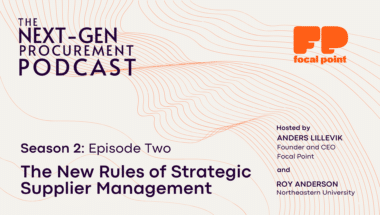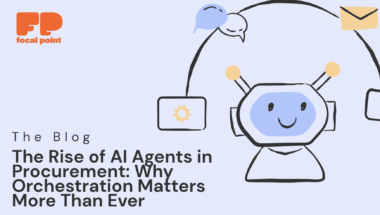Focal Point Founder and CEO Anders Lillevik and Wonder Services’ Amanda Prochaska team up to answer your intake questions. In this webinar, the pair explores the strategic opportunities intake creates for procurement organizations: from best practices to tackling challenges emerging due to procurement’s growing workload.
The following is an excerpt from their conversation. You can find the video version of this live event in its entirety here.
Moderator
So, we’ll get started, Amanda, would you like to introduce yourself first?
Amanda
I’m so happy to be here. It’s always a pleasure to be with both of you and talk about all things procurement. I’m Amanda Prochaska, I am the Chief Wonder Officer of Wonder Services. Anders, you smiled when I said that.
Anders
That’s awesome.
Amanda
I love my title. I didn’t like ‘CEO’, I didn’t feel like it fit for me. But we are all about change management process improvement and project management services. So we help deploy wonderful tools like Focal Point and many others within the procure tech space. I have a passion for doing that. I’ve been doing it for 21 years now. Which is crazy, four and a half of those at Wonder Services and previously in my corporate role.
Anders
So happy to be here today and have this conversation. So yeah, for those of you who don’t know me, I’m Anders Lilllevik. I am not a Wonder Officer. I’m the founder of Focal Point. I’ve been running Focal Point for about three and a half years now, and I’m a recovering Chief Procurement Officer.
I spent 20-plus years in procurement as a practitioner. So I was a CPO for companies like Fannie Mae, QB, Webster Bank, Citizens Bank, and I started Focal Point to, to deal with some of these issues we’re going to talk about today. Focal Point is a B2B SaaS platform for procurement organizations to optimize and standardize their processes.
Moderator
Exciting! Thank you both so much for introducing yourselves. Let’s jump right into it. So today we’re going to be talking about all things intake. We do have some pre-submitted questions for you guys to go over, so we’ll start with going through these, but we’ll definitely have an open Q& A session at the end. So let’s get started.
So question one, we’re talking about what intake is and why it’s so important. So let’s just get a baseline from the two of you.
What is intake, and why is it so important?
Amanda
Anders is going to have a lot more to say about this one than maybe I will. So I’ll go first and you can tag on your thoughts. But, truly when we’re working with all of our clients, one thing that I’m seeing more often than not is this seamless interaction between procurement and the rest of the organization.
With AI coming online and more user friendly options, it’s like a self service type of a feel where information and insights can be right at your fingertips. I think intake and procurement needs to involve more and more into intake solutions to meet that demand.
And another thing is; procurement can be confusing. I always tell people, if I’m a salesperson and I need to buy something, I don’t care that we have 15 different buying channels and nor do I care to learn what those are. So speaking from a change management hat, having intake is so beneficial to make sure that your end users don’t need to understand procurement, but they still get directed into the right places in the organization to make their purchases.
Anders
So I think between those two things, it’s a really important topic to have right now and for people in procurement to be considering an intake solution. So I’ll add to that: at the end of the day when I was in procurement as a practitioner, we would get demand coming all out of, you know, everywhere, right?
So you would walk the hallways, you’d pick up a project, you get an email, you pick up a project. Somebody would call you (back in the day when we had landlines) and you’d pick up a project. And it’s a matter of sort of figuring it out. How do you accumulate all this demand and then channel it in the right areas, right?
And I think now that there are solutions out there where you can actually go to one spot and either get help to finalize your transaction, whether that is a traditional, you know, I need to buy something. Great. Here’s the catalog item, here’s the rec, here’s the PO, and off you go. Right?
Maybe I need a contract. Maybe I need something that is purely tactical and they can do that. And do that in all the same way. You go to one spot, you get help, you can get redirected to say, all right, I need to book travel. Great. We’ll send you to that travel booking tool, or I need to deal with a supplier. Okay, fine. Here you go for that.
But more importantly, as a procurement practitioner, I also need a full blown procurement project. I need help with procurement. And it’s about making sure that people can go to one spot, figuring out what they need to do and how, and how they can get help from procurement in that one spot.
And I think, you know, as procurement leader, I think the important thing for me is to have a better experience for your users, being able to manage that process of taking in new projects and balancing them up against other priorities that you may have going on and look at things holistically across the board.
And we think about the stuff that you’re already working on right now. And then you got stuff coming in the front door and say, right, how do I stack these up in terms of priority? And I think that is again, like, why intake is important because it can actually make more visible where you’re spending your time, where you’re adding value and how you’re interacting with your clients internally.
Intake has been around for a long time. There are companies out there that created intake solutions.
In my opinion, it was fairly unichannel. Like, yeah, “everything’s going to turn into a PO at some point.” Well, no, that’s not always the case, right? But, still, intake’s been around for a minute. It just hasn’t really taken off until, you know, two years ago or something like that.
Moderator
Absolutely. I think that was really, really good. It’s always lovely to hear such passion from Anders. I mean that this is why you are doing what you’re doing, it’s because of what you just said. And so I always love hearing your insights there.
And I think this is a good baseline because we’re about to get into how intake’s changed and its future. So our next question is going to be talking about common challenges faced during the intake process and how they can be mitigated, which Anders, obviously I know a lot of your passion lies here, too. You want to go first on this one?
How has intake in procurement changed, and where’s it heading?
Anders
Yeah. I mean, at the end of the day, I think as you’re setting up your intake solution, the biggest problem that I always find is that people don’t necessarily know all their buying channels or know where everything’s going to end up. So they aren’t able to figure out, “how do I actually set this thing up to add the most value with the least amount of friction?”
And, you know, procurement is known for creating these 200-question questionnaires, right? Well, that doesn’t work anymore. So it’s a matter of creating some brevity around the amount of information that we collect to add the most value and then figuring out where to go from there.
And we have to put the user experience at heart, right? Like people could sometimes want to go from the Wild, Wild West to super high-level organization overnight. It doesn’t really work that well. So it’s about deciding: where are you going to add the most value? And going after that as a key tenant.
Amanda
Yeah, I would echo that. I think a lot of the challenges are just trying to define what this looks like, what your process actually is and how you want to design it into an intake tool. And it’s really changing the game when it comes to the mindset of procurement. So often, at least in my past, when I was designing these processes, it was very procurement-focused, like what does procurement need from this process?
And I think when you go into intake, it’s really about that customer journey. So it’s not just a process map, but it’s really thinking through how your customer moves through this process and ultimately gets what they need. And along the way you need to be thinking about, okay, what does this mean for procurement, but really kind of flipping it over to say, I need my customer to have this really nice, simple journey into procurement to get what they need.
Obviously, I do change management, right? So the way that these roll out, they should be very integrated into what people do.
But if there are spots where they’re not, you do have to think through – how do I get people to adopt this? We have a client right now that’s largely email-based, and we’re trying to move them into a system where communications can take place. So, if people are used to emailing Jane – because Jane’s super responsive and it’s really easy to do that, and now they have to go through intake – we have to think through what that transition looks like, and how do we make that happen.
Moderator
Yeah, absolutely. Anders, I think once you made a post that did really well talking about practicing empathy as CPOs and empathy in procurement, and I think a lot of change management is really thinking, okay, how is this affecting my people? What is their thought process and how can we make this as easy as possible?
Okay, so question three, the fun begins: digital transformation. And how has that impacted the procurement intake process? I think Amanda, what you just said is a good lead into this.
What should digital transformation look like for intake?
Amanda
Yeah. And I love this question because so often we get clients that are like, we have either one core or end-to-end system, but it still has its opportunities here and there.
Or, we’ve gone out and we’ve purchased best-in-breed solutions, right? Part of the reason why I started Wonder Services is that I started noticing this evolution within procurement and procure tech. And I started thinking about the core end users.
All of this procurement tech is awesome, right? And it’s making a difference in our world. But if end users get confused on where to go and how to use those. They’re not going to be adopted at the end of the day. And we’re wasting money and nobody wants that. So we need to think about this differently.
How, how can we make sure that end users really know where they need to go? Intake is a huge part of that solution. So I am glad to see intake kind of taking the spotlight. I have have an example of a potential client that we’re talking to, but they are on an end-to-end solution and they just brought on a vendor management solution which is great.They’re taking charge and these technologies are going to really make an impact.
But the question is, how do my end users know when to use the end-to-end and when to use the VMS? And that’s where intake really can help us. The end user doesn’t really need to know; intake can direct them to the right location. Anders, I’m sure you have some stuff to add to that.
Anders
Yeah, so it’s interesting, right? I kind of look at intake as just a part of the transformation of procurement technology. So I think at the core of it, you know, you need to get work in the front door and then you need to work on that work and you need to make sure the client is updated, right?
So at the end of the day, what we need is something that moves projects from left to right. And it could be a large project, like a full blown RFP, or it could be a single transaction – but at the end of the day, like you need one place to go one place to, to sort of figure out where, like how to execute and then track the progress along the way.
And I think that, you know, “Intake–” the word doesn’t do it justice, right? Because at the end of the day, it’s where the work gets done for end users. And procurement is kind of like the feet of the duck under water, right? Like you can only see what’s floating on top of the surface, and that’s what the user gets.
And then behind the scenes, there’s a lot of work being done that involves third parties inside the company. It could be risk, it could be legal, it could be compliance, it could be whatever. But at the end of the day, I think now that folks are starting to look at things as a process that can be followed.
And I think that that’s why I think it’s becoming so much more powerful. It’s kind of the focal point, if you will, where people go and figure out: here’s the status of my project, this is where my purchase order is sitting in the queue, right? Those kinds of things.
And I think having a bunch of systems, it’s not enough anymore. You need something that ties them together so that you get redirected to the right place. You get the help that you need. You get the updates that you need along the way. And I think that helps procurement people think more like a service organization rather than a back office function.
To hear more from Anders and Amanda’s past community Q&A’s, explore here.



